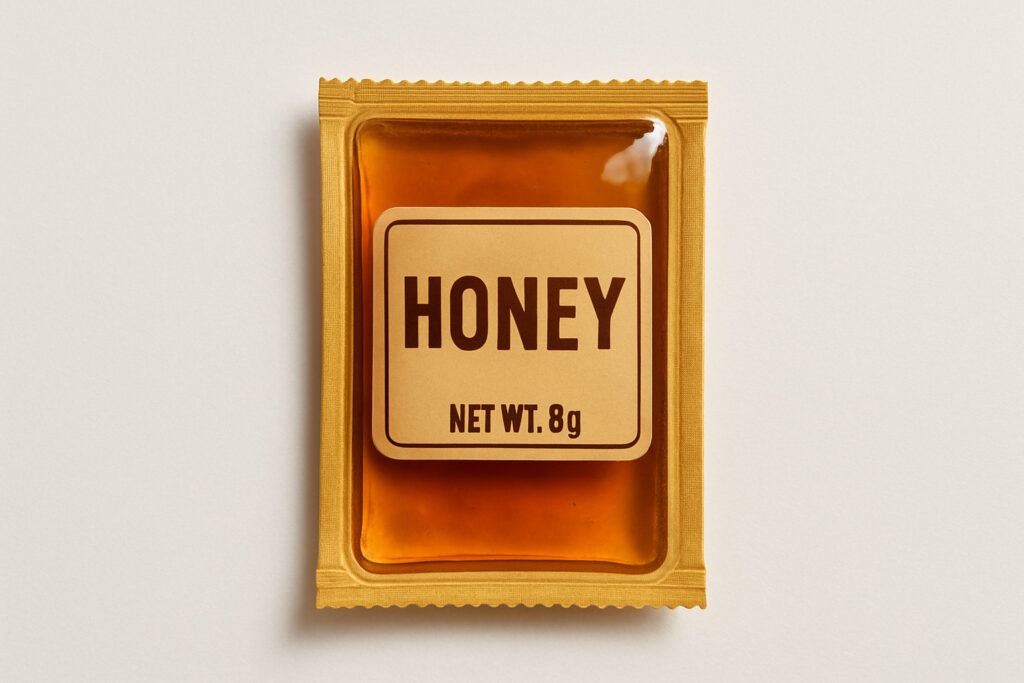Understanding the Honey Pack Phenomenon
A honey pack is a single-serving packet of honey, often marketed as a natural energy booster or sexual improvement supplement. However, the term has evolved beyond simple honey packets to include potentially dangerous products containing hidden pharmaceutical drugs.
What you need to know about honey packs:
- Pure honey packets – Safe, natural honey in portable sachets for travel or convenience
- “Royal Honey” products – Often contain undisclosed erectile dysfunction drugs like sildenafil or tadalafil
- Energy honey sticks – Legitimate honey products used by athletes and hikers for quick energy
- Gas station supplements – Frequently adulterated with prescription medications and pose serious health risks
The honey pack trend exploded on social media, particularly among college students seeking natural alternatives for energy and performance. But what started as innocent portable honey has become a concerning category of unregulated supplements.
The FDA has issued multiple warnings since 2017 about honey packs containing hidden drugs. In 2022, laboratory analysis found sildenafil (the active ingredient in Viagra) in products sold online as “natural” honey supplements.
While pure honey offers legitimate benefits like natural carbohydrates and antioxidants, many products marketed as honey packs contain dangerous, unlisted ingredients that can cause serious side effects – especially when combined with heart medications.
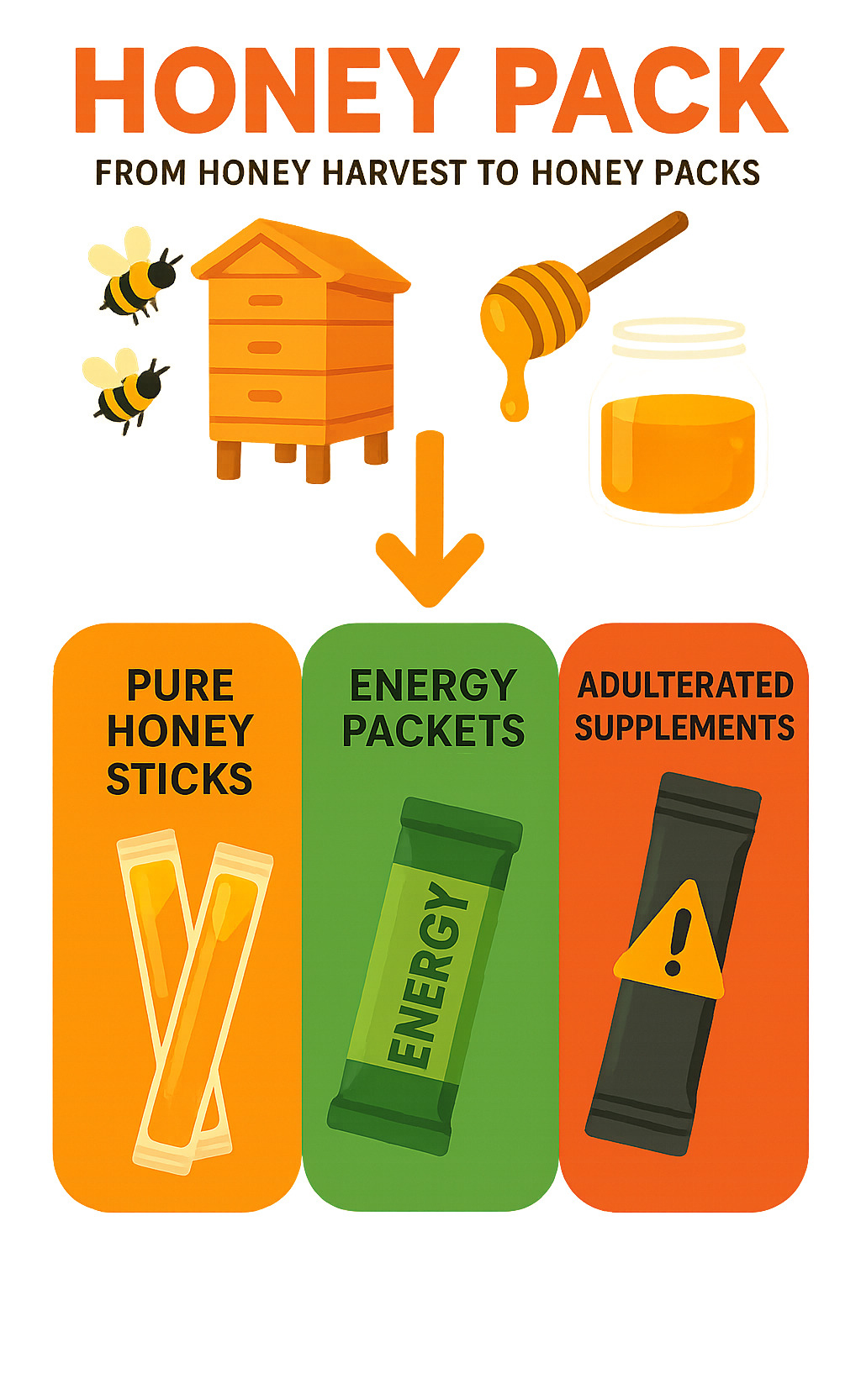
Honey pack terms simplified:
What Is a Honey Pack?
The term honey pack means different things to different people, and that’s where the confusion begins. If you’re just looking for a convenient way to carry honey, you’re probably thinking of legitimate honey packets. But if you’ve heard about honey packs on social media or in music, you might be referring to something entirely different – and potentially dangerous.
Pure honey packets are simple and straightforward. They’re small, portable sachets or tubes containing real honey, usually about 1-2 tablespoons worth. Think of them like ketchup packets, but filled with golden honey instead. These are perfect for camping trips, adding to your morning tea, or keeping in your gym bag for a natural energy boost.
But here’s where things get tricky. The slang term “honey pack” has taken on a whole new meaning, especially among younger consumers. This version usually refers to products marketed as sexual improvement supplements, often called “Royal Honey” or similar names. These products might contain honey, but they’re also loaded with herbs, royal jelly, and – most concerning – undisclosed pharmaceutical drugs.
The difference between these two types of honey pack products is like night and day. One is a simple food product you’d find in the organic section of your grocery store. The other is an unregulated supplement that could land you in the emergency room.
| Pure Honey Packet | Sexual Improvement “Honey Pack” |
|---|---|
| Contains only honey | May contain herbs, royal jelly, undisclosed drugs |
| FDA-regulated as food | Unregulated supplement |
| Safe for general consumption | Potential serious side effects |
| Transparent labeling | Often misleading marketing |
| Used for energy/sweetening | Marketed for sexual performance |
The confusion around honey pack terminology isn’t accidental. Some manufacturers deliberately use innocent-sounding names to market questionable products. They know that “honey” sounds natural and safe, which helps them fly under the radar of both regulators and consumers.
History and Rising Popularity
The honey pack trend didn’t happen overnight. It started gaining momentum through social media platforms, where college students and young adults began sharing their experiences with these products. What many didn’t realize was that they were often consuming prescription medications without knowing it.
Music references and viral videos fueled the fire, with many users treating these products like harmless energy drinks. The problem? Most people had no idea what they were actually putting in their bodies.
What began as a practical solution for outdoor enthusiasts and travelers has morphed into something much more concerning. The rise of online marketplaces made it easier than ever for questionable products to reach consumers without proper oversight or safety testing.
The popularity surge also coincided with a growing interest in “natural” alternatives to prescription medications. Many people assumed that anything containing honey must be safe and natural – a dangerous misconception that continues to put consumers at risk.
Types & Ingredients of Honey Packs
When you’re shopping for a honey pack, it’s important to understand that not all products are created equal. The market has evolved into distinct categories, each with very different safety profiles and purposes.
Pure honey products represent the safest option. These include traditional honey sticks (those clear plastic straws filled with golden honey), small sachets of liquid honey, and flavored honey tubes with natural additions like lemon or vanilla. These products contain exactly what you’d expect – honey and nothing else concerning.
Legitimate energy products take things a step further by combining honey with performance-focused ingredients. Sports honey packets often include added electrolytes for hydration, while organic honey sticks marketed to athletes maintain transparent labeling about their contents. Raw honey sachets from reputable sources fall into this category too.
The concerning category involves “Royal Honey” products that promise sexual improvement benefits. These products typically start with honey as a base ingredient but then add royal jelly, bee pollen, and various herbal extracts like ginseng, tongkat ali, and maca root. You might also find date extract and walnut oil listed on the label.
Here’s where things get dangerous: many of these products contain hidden pharmaceutical drugs like sildenafil (the active ingredient in Viagra) or tadalafil (found in Cialis). The scientific research on hidden drugs conducted by the FDA has repeatedly found these prescription medications in products sold as “natural” honey supplements.
What makes this particularly troubling is that consumers think they’re buying a natural product when they’re actually getting unlisted prescription drugs. This can lead to serious health complications, especially for people taking heart medications or blood pressure drugs.
How to Read a Label
Learning to spot red flags on honey pack labels could literally save your life. The marketing language often tells you everything you need to know about a product’s safety.
Watch out for these warning signs: Claims about sexual improvement or performance improvement should immediately raise concerns. Vague ingredient lists that don’t clearly state what’s inside are another major red flag. Products without proper FDA disclaimers or those marketed as “natural Viagra” are best avoided entirely.
Look for these positive indicators instead: Clear information about honey source and grade shows transparency. Proper nutritional information and certifications from recognized organizations indicate legitimate products. Contact information for the manufacturer and realistic claims about energy or sweetening benefits are also good signs.
The serving size should be clearly stated, and any certification seals should be from organizations you can verify. If a product makes claims that seem too good to be true – especially regarding sexual performance – trust your instincts and look elsewhere.
Legitimate honey products focus on energy, sweetening, or general wellness benefits. They don’t promise to replace prescription medications or cure serious health conditions.
Honey Pack Benefits vs Scientific Evidence
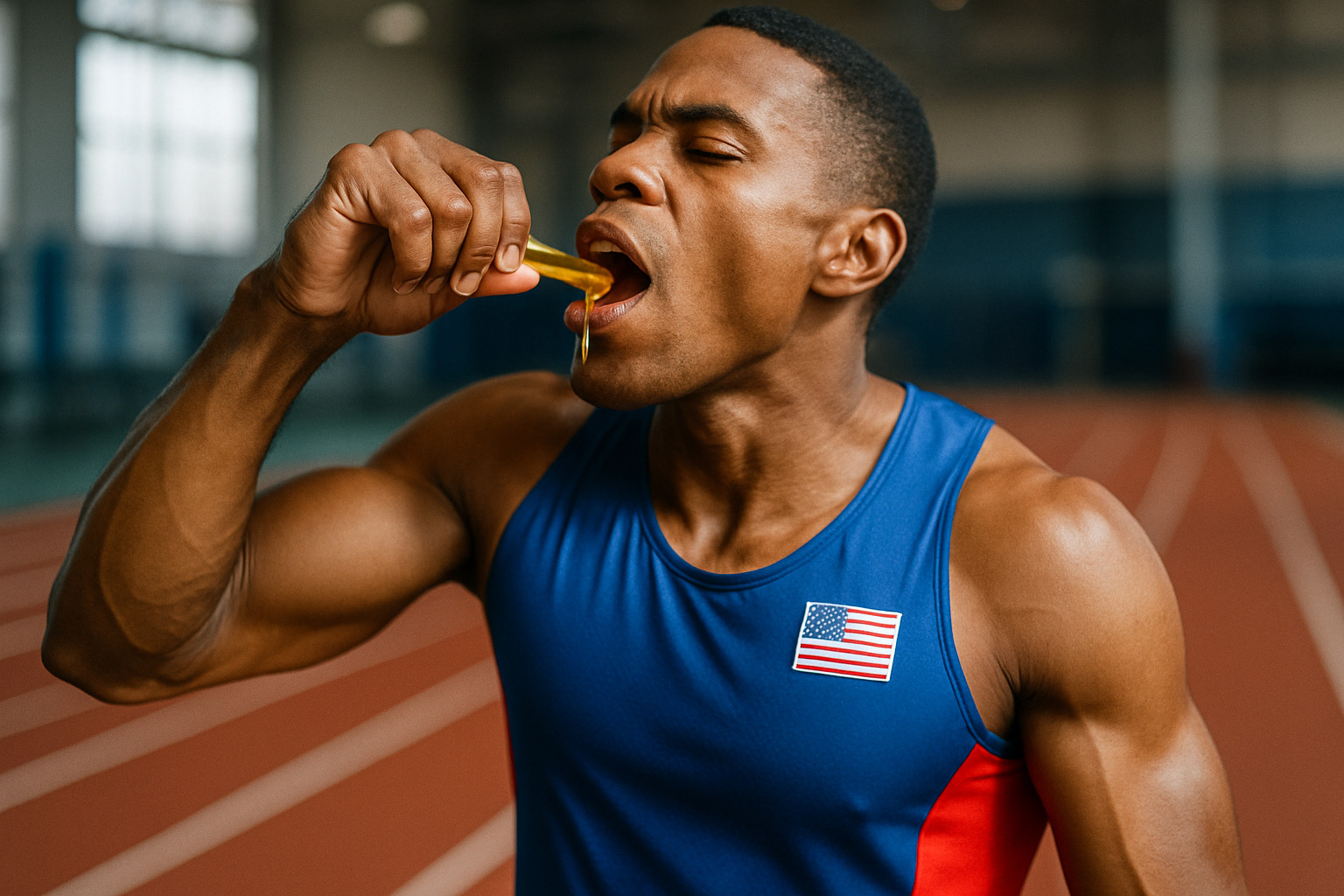
When it comes to honey pack products, separating fact from fiction can feel like navigating a maze. The truth is, the benefits you’ll actually experience depend entirely on what’s really inside that little packet.
Let’s start with what we know works. Pure honey genuinely offers natural carbohydrates that your body can quickly convert to energy. It also contains antioxidants and trace nutrients that provide some wellness benefits, plus antimicrobial properties that have been recognized for centuries. The real advantage? Convenience – you can toss a honey packet in your gym bag or backpack without worrying about sticky spills.
But here’s where things get murky. Many products marketed as honey packs make bold claims about sexual performance improvement, dramatic stamina boosts, and even cure-all health benefits. These claims simply aren’t backed by solid science when it comes to pure honey.
Here’s something interesting: research shows that up to 25% of men experience performance anxiety, which helps explain why honey pack products have gained such popularity. When someone tries a new product and feels more confident, that psychological boost can create real improvements – even if the product itself isn’t doing the heavy lifting.
The placebo effect is particularly powerful when it comes to performance-related concerns. If you believe something will help you feel more energetic or confident, you might actually experience those benefits, regardless of what’s in the packet.
Does a Honey Pack Really Boost Energy?
This is where honey pack products can actually deliver on their promises – but probably not in the way you’d expect.
Pure honey contains natural sugars, mainly glucose and fructose, which your body absorbs relatively quickly. When you squeeze a honey stick before a workout or hike, you’re essentially giving yourself a shot of easily accessible fuel. Your blood sugar rises, and you feel more energetic.
The catch? This energy boost is temporary and similar to what you’d get from any simple carbohydrate. A banana, a piece of toast, or even a sports drink would provide comparable results. The magic isn’t in the honey itself – it’s in the portability and convenience of the packaging.
Athletes have been using honey sticks for years because they’re mess-free, don’t require refrigeration, and provide quick energy when you need it most. But don’t expect miracles – you’re getting a normal carbohydrate boost, not some special performance improvement.
Is a Honey Pack Effective for Sexual Improvement?
This is where we need to have an honest conversation about what science actually shows us.
Scientific research on ginseng and erectile function reveals that even ginseng – one of the most popular ingredients in honey packs – has only a “trivial effect” on erectile function compared to placebo. If one of the star ingredients barely moves the needle, what does that tell us about the honey itself?
Pure honey has no proven effect on sexual performance in humans. Zero. Any benefits people experience from legitimate honey products likely come from the placebo effect, a temporary energy boost, or the psychological confidence that comes from trying something new.
But here’s the concerning part: some products sold as honey packs do contain hidden erectile dysfunction drugs like sildenafil or tadalafil. These medications can be effective, but they’re also dangerous without medical supervision. If a honey pack actually “works” for sexual improvement, it might not be the honey doing the work – and that’s a serious safety red flag.
The bottom line? If you’re looking for natural wellness support, pure honey can be part of a healthy lifestyle. But if you’re hoping for dramatic performance improvements, you’re likely setting yourself up for disappointment – or worse, unknowingly taking prescription drugs.
Risks, Regulations & Safe Usage Tips
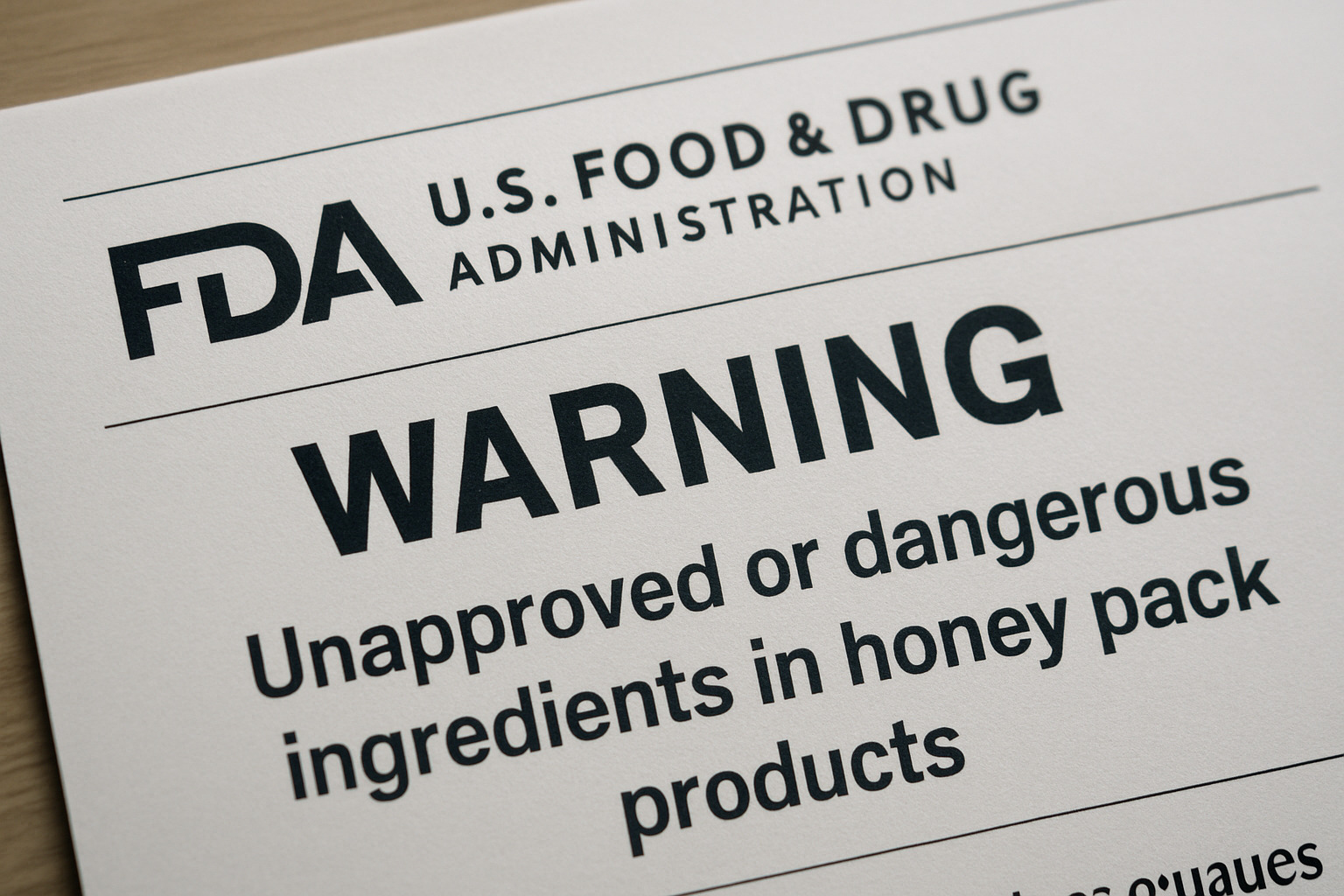
The reality about honey pack safety isn’t pretty. Since 2017, the FDA has been playing whack-a-mole with dangerous products, issuing warning after warning about honey packs containing hidden prescription drugs.
Here’s what makes these products so risky: they’re sold as “natural” supplements, but many contain the same active ingredients found in prescription medications like Viagra or Cialis. The difference? No doctor supervision, no dosage control, and often no idea what you’re actually consuming.
Dangerous blood pressure drops top the list of serious risks, especially if you’re taking nitrate medications for heart conditions. This combination can be life-threatening. Priapism – painful erections lasting over four hours – is another emergency that requires immediate medical attention.
Allergic reactions become unpredictable when you don’t know what’s actually in the product. Some people have experienced severe reactions to undisclosed ingredients that weren’t listed on the label.
The regulatory landscape makes things worse. Honey pack products fall into a gray area where they’re not regulated as medications, meaning companies can sell them without proving they’re safe or effective. It’s like the Wild West of supplements.
Drug interactions pose another hidden danger. If you’re taking heart medications, blood thinners, or other prescriptions, these unlisted ingredients can cause serious complications that even your doctor won’t see coming.
How to Identify Safe Products
Shopping smart for honey pack products means becoming a detective. Reputable sources should be your first filter – if you’re buying from a gas station or a sketchy website, you’re already in risky territory.
Third-party testing separates legitimate companies from fly-by-night operations. Quality manufacturers often provide lab results showing exactly what’s in their products. If they won’t share this information, that’s a red flag.
Transparent labeling should tell you everything that’s inside. If the ingredient list is vague or missing, walk away. Sexual improvement claims are basically neon signs warning you about potential adulteration.
Take time to research the manufacturer. Established companies with good reputations have more to lose by selling dangerous products. Check reviews, look for contact information, and see how long they’ve been in business.
For more guidance on making safe wellness choices, our wellness and self-care resources can help you steer these decisions with confidence.
What to Do if Side Effects Occur
If you experience any adverse effects after consuming a honey pack product, don’t tough it out. Stop use immediately – this isn’t the time to “see if it gets better.”
Seek medical attention right away for serious symptoms like chest pain, vision changes, or prolonged erections. These aren’t minor inconveniences – they’re medical emergencies that require professional care.
Be completely honest with healthcare providers about what you consumed. This isn’t the time to be embarrassed. Medical professionals need accurate information to help you effectively.
Report adverse events to FDA MedWatch. Your experience could help protect others from similar dangers. The FDA relies on these reports to identify problem products and issue warnings.
Keep the product packaging for identification purposes. Medical professionals and regulators need to know exactly what you consumed to provide proper treatment and take appropriate action.
DIY Honey Packs & Proper Storage
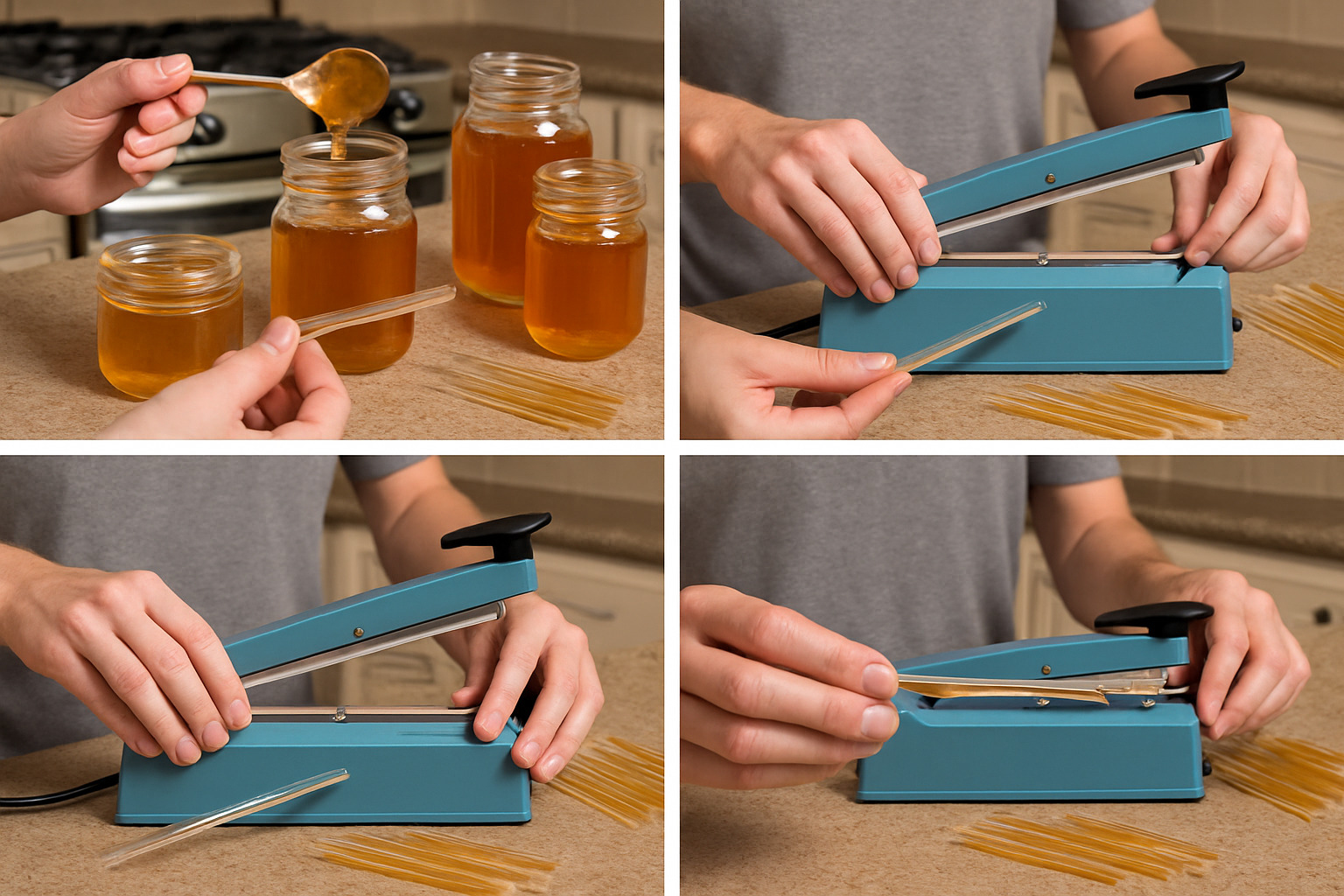
Creating your own honey pack products is one of the smartest ways to enjoy the benefits of portable honey while knowing exactly what you’re consuming. Unlike questionable products sold at gas stations, homemade honey packets give you complete control over ingredients and quality.
The beauty of making your own honey pack lies in its simplicity. You’ll need just a few basic supplies: pure honey (either raw or filtered works perfectly), plastic straws or small food-grade bags, an impulse sealer or heat source, scissors, and labels for dating your creations.
Storage is surprisingly straightforward when you do it right. Properly sealed honey packets can last about one year at room temperature when stored in a cool, dry place. If you want to extend their shelf life, refrigeration can keep them fresh for up to two years, though the honey may crystallize (which is completely normal and safe).
Here’s a travel tip that might surprise you: TSA allows small honey packets in carry-on luggage, making your homemade honey sticks perfect companions for flights and trips.
Step-by-Step: Make Your Own Honey Sticks
The process is more forgiving than you might expect. Start by warming your honey gently to around 80-100°F – this makes it flow much easier and prevents sticky disasters. You can do this by placing the honey container in warm water for a few minutes.
Next, prepare your containers by cutting plastic straws to your desired length or setting up small zip-top bags. A small funnel or squeeze bottle becomes your best friend here, helping you fill each container carefully without creating a sticky mess all over your kitchen counter.
The sealing step is where the magic happens. Use an impulse sealer if you have one, or carefully heat-seal with pliers and a small flame if you’re working with plastic straws. Take your time here – a good seal prevents leaks and keeps your honey fresh.
Don’t forget to label and date each packet with the honey type and creation date. Finally, test your seals by gently squeezing each packet to make sure there are no weak spots that might cause leaks later.
Creative Uses Beyond Eating
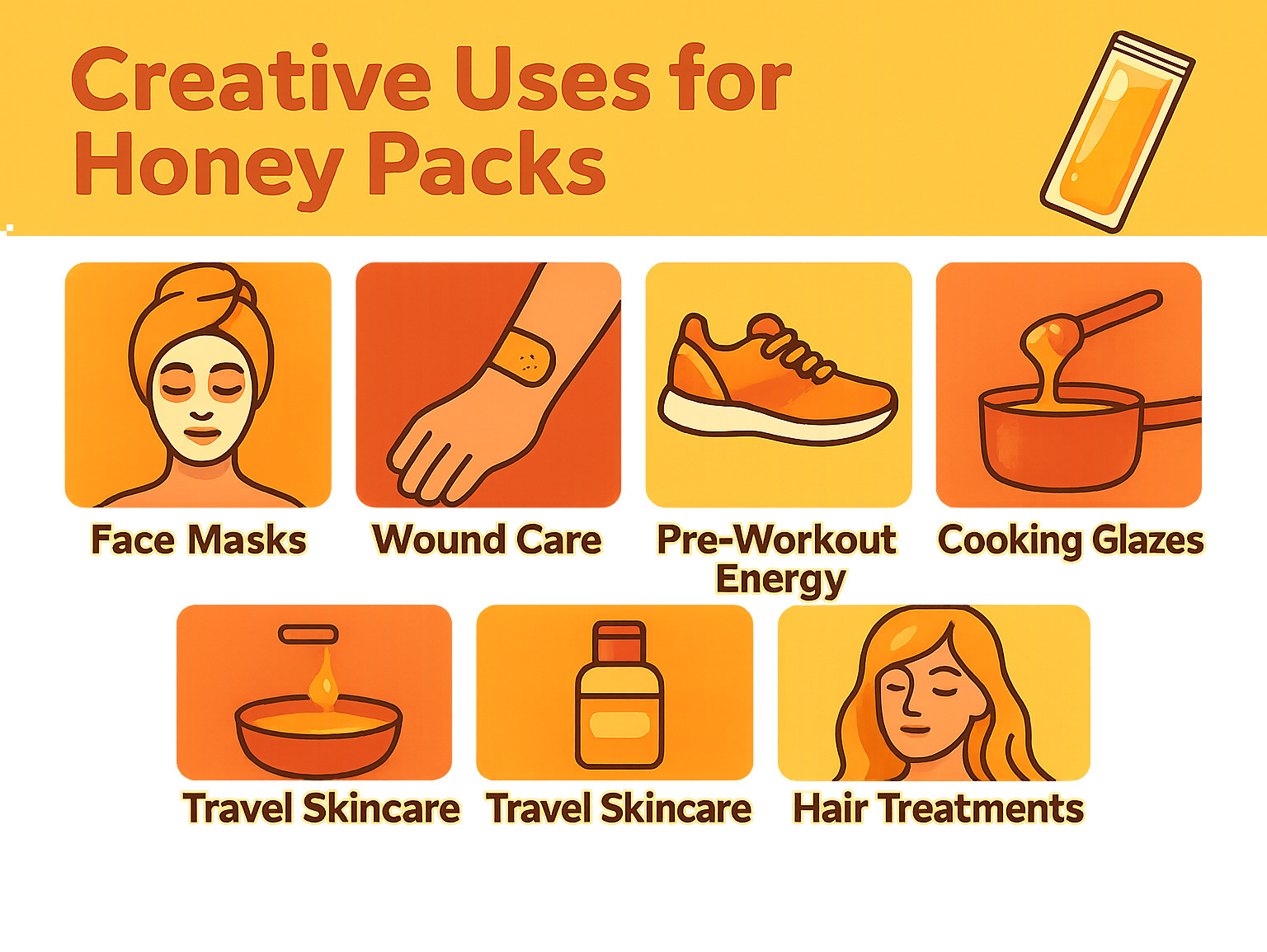
Your homemade honey pack collection can serve purposes far beyond simple snacking. Face masks made from single honey packets provide moisturizing and antibacterial benefits that many expensive skincare products can’t match. Simply squeeze a packet onto clean skin, let it work its magic for 10-15 minutes, then rinse with warm water.
Hair treatments are another wonderful application – honey’s natural conditioning properties can add shine and softness to dry or damaged hair. Mix a honey packet with a little water to create a conditioning treatment that travels perfectly.
For cooking enthusiasts, these portable packets become convenient marinades and glazes for grilling or roasting. The single-serving size makes it easy to add the perfect amount of sweetness to sauces without waste.
Travel skincare gets a major upgrade with honey packets. They’re compact, TSA-friendly, and provide emergency moisturizing for dry airplane skin or unexpected weather conditions. Plus, they serve as a mess-free sweetening option for hotel room tea or coffee when you’re not sure about the quality of provided sweeteners.
Athletes and outdoor enthusiasts love having emergency energy sources that don’t require refrigeration or special handling. A honey packet provides quick, natural energy during long hikes, bike rides, or any activity where you need a reliable boost without the crash that comes from processed energy products.
Frequently Asked Questions about Honey Packs
We hear these questions about honey pack products all the time, and honestly, they’re really important to address. The confusion around these products means people often don’t know what’s safe or what to expect.
Are Honey Packs Safe for Children, Pregnant Women, or People with Diabetes?
This is probably our most common safety question, and the answer depends entirely on what type of honey pack you’re talking about.
If you have a baby under 12 months old, please don’t give them any honey products at all. Raw honey can contain botulism spores that their little immune systems can’t handle yet. This is a serious safety issue that many parents don’t realize.
For pregnant women, pure honey packets are generally fine and can be a nice natural sweetener. However, we strongly recommend avoiding any honey pack products that make sexual improvement claims or contain herbal additives. Your body is already working hard enough without unknown ingredients!
If you’re managing diabetes, honey is still sugar, even though it’s natural. A typical honey pack contains about 15-20 grams of carbohydrates, which will definitely affect your blood glucose levels. It’s always smart to check with your healthcare provider about incorporating honey products into your routine.
How Long Do Honey Packs Last Before They Expire?
Here’s something fascinating – pure honey never actually spoils! Archaeologists have found edible honey in ancient Egyptian tombs. But honey pack products with other ingredients are a different story.
Homemade honey sticks that you make yourself will stay good for about a year at room temperature, or up to two years if you keep them in the refrigerator. The honey might crystallize over time, but that doesn’t mean it’s gone bad – just warm it up gently.
Commercial honey packets typically have expiration dates printed on them, usually around 2-3 years from manufacture. These dates are more about quality than safety for pure honey products.
Products with added ingredients like royal jelly, herbs, or other supplements should always be used according to the manufacturer’s guidelines. These additional ingredients can break down over time and may become less effective or even unsafe.
How Does a Honey Pack Compare with Other Energy Gels or ED Pills?
This comparison really highlights why it’s so important to understand what you’re actually buying when you look for a honey pack.
For energy purposes, honey works similarly to commercial sports gels – both provide quick carbohydrates that your body can use immediately. The main advantages of honey are that it’s completely natural and usually less expensive. The downside is that honey can crystallize in cold weather, while synthetic gels stay liquid.
For sexual improvement, this is where things get concerning. Legitimate honey products have absolutely no proven benefits for sexual performance. If you’re looking for actual help with erectile dysfunction, prescription medications are tested, regulated, and effective when used properly under medical supervision.
The real danger comes from honey pack products that contain hidden pharmaceutical drugs. These create uncontrolled dosing situations where you don’t know how much medication you’re getting, which can be incredibly dangerous, especially if you’re taking heart medications or blood pressure drugs.
Conclusion
The honey pack trend has revealed both the wonderful possibilities and serious pitfalls of our modern supplement world. What started as a simple, convenient way to enjoy honey has evolved into something much more complex – and potentially dangerous.
Here’s what we’ve learned: Pure honey packets are fantastic little powerhouses of natural energy and convenience. They’re perfect for hiking, travel, or just sweetening your tea on the go. But the market has been flooded with questionable products that masquerade as natural remedies while hiding prescription drugs inside.
The key to staying safe is becoming an informed consumer. Stick to reputable manufacturers who believe in transparent labeling. Avoid anything promising sexual miracles – these claims are red flags for potentially dangerous products. And remember, if you have legitimate health concerns, your healthcare provider is always your best resource.
We love the idea of incorporating natural ingredients like honey into your wellness routine. There’s something beautifully simple about enjoying pure honey the way nature intended. Making your own honey sticks can be a fun weekend project that gives you complete control over what you’re consuming.
At Beyond Beauty Lab, we believe knowledge is your superpower when it comes to wellness choices. The honey pack phenomenon is a perfect example of why understanding what you’re putting in your body matters so much. Pure honey has been nourishing humans for thousands of years – but only when it’s actually pure honey.
For more guidance on building a natural wellness routine that truly works, check out our Ultimate Guide to Wellness and Well-Being. You’ll find safe, effective approaches to improving your health naturally.
Remember this simple truth: when it comes to honey pack products, your best defense is staying curious, asking questions, and never being afraid to dig deeper into what you’re buying. Your body deserves nothing less than complete honesty about what you’re feeding it.

